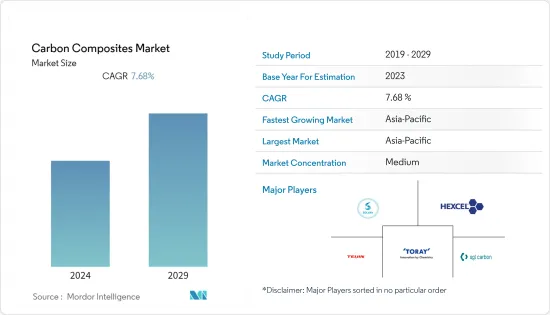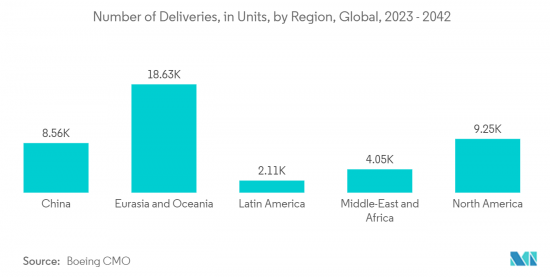 |
市場調査レポート
商品コード
1404367
炭素複合材料-市場シェア分析、産業動向と統計、2024~2029年の成長予測Carbon Composites - Market Share Analysis, Industry Trends & Statistics, Growth Forecasts 2024 - 2029 |
||||||
● お客様のご希望に応じて、既存データの加工や未掲載情報(例:国別セグメント)の追加などの対応が可能です。 詳細はお問い合わせください。
| 炭素複合材料-市場シェア分析、産業動向と統計、2024~2029年の成長予測 |
|
出版日: 2024年01月04日
発行: Mordor Intelligence
ページ情報: 英文 160 Pages
納期: 2~3営業日
|
- 全表示
- 概要
- 目次
炭素複合材料市場は、今年末までに205.90キロトンに達すると推定されます。
今後5年間で298.10キロトンに達し、予測期間中のCAGRは7.68%を超えると予測されています。

COVID-19は炭素複合材料セクターにマイナスの影響を与えました。世界のロックダウンと各国政府による厳しい規則により、ほとんどの生産拠点が閉鎖され、壊滅的な打撃を受けました。それにもかかわらず、2021年以降事業は回復しており、今後数年間で大幅に増加すると予想されます。
主要ハイライト
- 市場を牽引する主要要因は、航空宇宙・防衛産業からの需要増と風力エネルギー分野からの需要増です。
- しかし、他の複合材料に比べて製造コストが高いことや、代替品の存在が市場成長の妨げとなっています。
- とはいえ、3Dプリンティングにおける炭素複合材料の採用拡大や燃料電池電気自動車(FCEV)の需要増加が市場機会となります。
- アジア太平洋が最も高い市場シェアを占めており、予測期間中は市場を独占すると予想されます。
炭素複合材料市場動向
航空宇宙・防衛用途が市場を独占する
- 航空宇宙・防衛産業は、炭素複合材市場の最大のエンドユーザーです。当初、航空宇宙製造はアルミニウム、スチール、チタンなどの金属に大きく依存しており、航空機総重量の約70%を占めていました。しかし近年では、軽量化、極限耐性、断熱性、レーダー吸収などの特性に対する嗜好の高まりにより、航空宇宙製造における炭素複合材の使用量が急増しています。
- これらの複合材料は、炭素マトリックスに埋め込まれた炭素繊維で構成されています。これらの複合材料は、錆びたり腐食したりしないため、航空機のメンテナンス・コストも下げることができます。
- 航空宇宙産業における炭素繊維ベースの複合材料の主要用途には、クリップ、クリート、ブラケット、リブ、ストラット、ストリンガー、チップ、翼端、その他の特殊部品などの航空機部品の製造への使用があります。
- さらに、航空宇宙産業は、主翼のトーションボックスや胴体パネルのような、より大きな構造物へのこれらの複合材料の使用も模索しています。防衛産業では、炭素複合材はミサイル防衛、地上防衛、軍用船舶に使用されています。
- ボーイング・コマーシャル・アウトルック2023~2042によると、国際交通の復活と国内航空旅行がパンデミック前のレベルに戻っていることから、同社は2042年までに4万2,595機の新しい民間ジェット機の世界需要を示し、その価値は8兆米ドルになると予測しています。
- 北米が9,250機の納入で最大のシェアを占め、次いでユーラシアと中国が続き、2042年までの新型機の納入総数は9,645機と推定され、業界の需要増加を示しています。
- 2022年、世界の主要航空機メーカーのひとつであるエアバスは、84の顧客に約661機の民間航空機を納入したが、これは2021年と比較して8%の増加です。また、2022年にはさらに820件の新規純受注を獲得しています。2022年末時点のエアバスの受注残は7,239機で、2019年以降で最多となった。一方、ボーイングは2022年の商業受注を約774機と報告し、2022年に約480機を納入しています。
- したがって、前述の要因から、航空宇宙・防衛分野が調査対象市場を独占すると予想されます。

アジア太平洋が市場を独占する
- アジア太平洋は、世界の炭素複合材市場で最も高いシェアを占めています。炭素複合材料の需要のほとんどは、航空宇宙・防衛、自動車、スポーツ・レジャーなどの用途によるものです。
- 炭素複合材料は、その高い強度対重量比、耐腐食性、加工性の特徴により、自動車産業で非常に大きな需要を目の当たりにしています。軽量でありながら強靭で、燃費の低減に貢献するという特徴から、さまざまな自動車用途で金属に取って代わりつつあります。
- 国際自動車建設機構(OICA)によると、中国の自動車生産台数は2022年に2,702万台に達し、同時期の2021年比で3%増加しました。中国の自動車市場は、COVID-19の発生、構造的なチップ不足、地域の地政学的紛争など、いくつかのマイナス要因の影響にもかかわらず、2022年に成長を遂げました。
- 国際貿易局(ITA)によると、中国は年間販売台数、生産台数ともに世界最大の自動車市場であり続けています。国内生産台数は2025年までに3,500万台に達すると予想されています。
- インドの自動車産業は、さまざまな分野で目覚ましい成長を遂げ、前向きな発展を見せた。インド自動車工業会(SIAM)によると、2022年4月から2023年3月までの国内の自動車産業は、乗用車、商用車、三輪車、二輪車、四輪車を含む合計25億9,931万8,867台を生産し、2021年4月から2022年3月と比較して約12.5%の成長を記録しました。
- 日本自動車販売協会連合会(自販連)と全国軽自動車協会連合会(軽自協)が発表した統計によると、2022年の国内新車販売台数は前年比5.6%減の420万1,321台となり、4年連続で前年割れとなった。世界の半導体不足が続き、自動車メーカーは生産制限を余儀なくされています。
- さらに、航空宇宙・防衛産業は炭素複合材市場の最大のエンドユーザーです。軽量化、極限耐性、断熱性、レーダー吸収といった特性への嗜好が高まる中、航空宇宙製造における炭素複合材の使用量は急速に伸びています。
- 航空宇宙企業エアバスのプレスリリースによると、2023年4月、今後20年間で、中国の航空輸送量は年率5.3%で成長し、世界平均の3.6%を大きく上回ると予測されています。このため、2041年までに8,420機の旅客機と貨物機が必要となり、これは今後20年間に世界で必要とされる新型航空機の20%以上、約3万9,500機となります。
- 国際航空運送協会(IATA)の報告書によると、インドは予測期間終了までに世界第3位の航空市場になる展望で、2030年には中国と米国を抜いて世界第3位の航空旅客市場になります。
- さらに、炭素複合材料は、その優れた強度、軽量性、強靭性により、スポーツ用品にますます使用されるようになっています。このように、スポーツ用品への需要の高まりは、予測期間中の市場の成長にプラスに働くと予想されます。
- 公式データによると、中国のエレクトロニクス部門は2022年に安定した成長を記録し、生産と投資の面で堅調な成長を支えました。工業情報化省によると、同部門の主要企業の付加価値額は2021年同期比で7.6%増加し、全産業の付加価値額を4ポイント上回った。このように、エレクトロニクス製品の需要の大幅な増加が、同産業の炭素複合材料の需要を支えています。
- 中国のスポーツ用品市場は、2022年に開催される北京冬季オリンピックのおかげで成長を目の当たりにしています。オリンピックの熱狂は同国のスポーツ産業を加速させました。スポーツ用品メーカーや業界関係者は、この分野が消費者のスポーツ活動や消費意欲を刺激すると期待しています。
- 上記の要因はすべて、今後数年間の炭素複合材市場を牽引すると予想されます。予測期間中、アジア太平洋が市場を独占すると予想されます。
炭素複合材料産業概要
世界の炭素複合材市場は、その性質上、部分的に断片化されています。主要参入企業(順不同)には、Toray Industries Inc.、Solvay、Hexcel Corporation、Teijin Limited、SGL Carbon SEなどがあります。
その他の特典:
- エクセル形式の市場予測(ME)シート
- 3ヶ月間のアナリスト・サポート
目次
第1章 イントロダクション
- 調査の前提条件
- 調査範囲
第2章 調査手法
第3章 エグゼクティブサマリー
第4章 市場力学
- 促進要因
- 航空宇宙・防衛産業からの需要増加
- 風力エネルギー分野からの需要増加
- 抑制要因
- 他の複合材料に比べて製造コストが高い
- 代替品の存在
- 産業バリューチェーン分析
- ポーターのファイブフォース分析
- 供給企業の交渉力
- 消費者の交渉力
- 新規参入業者の脅威
- 代替品の脅威
- 競合の程度
第5章 市場セグメンテーション(市場規模(数量ベース))
- マトリックス
- ハイブリッド
- メタル
- セラミックス
- 炭素
- ポリマー
- 熱硬化性
- 熱可塑性
- プロセス
- プリペグレイアッププロセス
- 引抜と巻取
- ウェットラミネーションとインフュージョンプロセス
- プレスと射出工程
- その他のプロセス
- 用途
- 航空宇宙・防衛
- 自動車
- 風力タービン
- スポーツ・レジャー
- 土木工学
- 海洋
- その他の用途
- 地域
- アジア太平洋
- 中国
- インド
- 日本
- 韓国
- ASEAN諸国
- その他のアジア太平洋
- 北米
- 米国
- カナダ
- メキシコ
- 欧州
- ドイツ
- 英国
- フランス
- イタリア
- その他の欧州
- 南米
- ブラジル
- アルゼンチン
- その他の南米
- 中東・アフリカ
- サウジアラビア
- 南アフリカ
- その他の中東とアフリカ
- アジア太平洋
第6章 競合情勢
- M&A、合弁事業、提携、協定
- 市場ランキング分析
- 主要企業の戦略
- 企業プロファイル
- Carbon Composites Inc.
- China Composites Group Corporation Ltd
- Epsilon Composite
- Hexcel Corporation
- Mitsubishi Chemical Corporation
- Nippon Carbon Co. Ltd
- Plasan
- Rockman
- SGL Carbon
- Solvay
- Teijin Limited
- Toray Industries Inc.
第7章 市場機会と今後の動向
- 3Dプリンティングにおける炭素複合材料の採用拡大
- 燃料電池電気自動車(FCEV)の需要増加

The carbon composites market is estimated to be at 205.90 kilotons by the end of this year. It is projected to reach 298.10 kilotons in the next five years, registering a CAGR of over 7.68% during the forecast period.
COVID-19 had a negative impact on the carbon composites sector. Global lockdowns and severe rules enforced by governments resulted in a catastrophic setback as most production hubs were shut down. Nonetheless, the business has been recovering since 2021 and is expected to rise significantly in the coming years.
Key Highlights
- The major factors driving the market are increasing demand from the aerospace and defense industry and increasing demand from the wind energy sector.
- However, the high cost of manufacturing in comparison to other composites and the presence of substitutes are hindering the market growth.
- Nevertheless, the growing adoption of carbon composites in 3D printing and increasing demand from fuel cell electric vehicles (FCEVs) will be the market opportunities.
- The Asia-Pacific region accounts for the highest market share and is expected to dominate the market during the forecast period.
Carbon Composites Market Trends
Aerospace and defense applications to dominate the market
- The aerospace and defense industry is the largest end-user of the carbon composite market. Initially, aerospace manufacturing used to rely heavily on metals like aluminum, steel, and titanium, which used to account for around 70% of the total aircraft weight. However, in recent years, owing to increasing preferences for properties like weight reduction, extreme resistance, insulation, and radar absorption, the usage of carbon composites in aerospace manufacturing has been growing rapidly.
- These composites consist of carbon fibers embedded in a carbon matrix. These composite materials also bring down the maintenance cost of the airplane as the materials do not rust or corrode.
- In the aerospace industry, some key applications of carbon-fiber-based composites include their use in manufacturing aircraft parts, such as clips, cleats, brackets, ribs, struts, stringers, chips, wing-leading edges, and other special parts.
- Moreover, the aerospace industry is also exploring the uses of these composites in larger structures, like wing torsion boxes and fuselage panels. In the defense industry, carbon composites are used in missile defense, ground defense, and military marine.
- According to the Boeing Commercial Outlook 2023-2042, with a resurgence in international traffic and domestic air travel back to pre-pandemic levels, the company is projected to exhibit a global demand for 42,595 new commercial jets by 2042, valued at USD 8 trillion.
- North America accounts for the largest share with 9,250 deliveries, followed by Eurasia and China, with the total deliveries of new airplanes estimated to be 9,645 units by 2042, indicating rising demand from the industry.
- In 2022, Airbus, one of the major aircraft manufacturers across the world, delivered around 661 commercial aircraft to 84 customers, which is an 8% increase compared to 2021. It also has received an additional 820 net new orders in 2022. At the end of 2022, Airbus' backlog was 7,239 aircraft, the highest number since 2019. On the other hand, Boeing has reported around 774 commercial orders for 2022 and has delivered around 480 aircraft in 2022.
- Hence, due to the aforementioned factors, the aerospace and defense sector is expected to dominate the market studied.

Asia Pacific to dominate the market
- Asia-Pacific accounts for the highest share of the global carbon composites market. Most of the demand for carbon composites comes from applications in aerospace and defense, automotive, sports and leisure, etc.
- Carbon composites have been witnessing tremendous demand in the automotive industry owing to their high strength-to-weight ratios, corrosion resistivity, and workability features. They have been replacing metals in various automotive applications due to their lightweight but tough features, which contribute to lesser fuel consumption.
- According to the Organisation Internationale des Constructeurs d'Automobiles (OICA), vehicle production in China reached a total of 27.02 million units in 2022, an increase of 3% over 2021 for the same period. China's auto market experienced growth in 2022 despite the impact of several negative factors, including the outbreak of COVID-19, a structural chip shortage, and local geopolitical conflicts.
- According to the International Trade Administration (ITA), China remains the world's largest auto market in terms of both annual sales and production. Domestic production is expected to reach 35 million units by 2025.
- The Indian automotive industry showed a positive development with remarkable growth across various sectors. According to the Society of Indian Automobile Manufacturers (SIAM), the automotive industry in the country produced a total of 2,59,31,867 vehicles, including passenger vehicles, commercial vehicles, three-wheelers, two-wheelers, and quadricycles from April 2022 to March 2023, registering a growth of around 12.5% compared to April 2021-March 2022.
- According to statistics released by the Japan Automobile Dealers Association and the Japan Light Motor Vehicle Association, a total of 4,201,321 new cars were sold in Japan in 2022, down by 5.6% Y-o-Y, marking the fourth consecutive year of decline. The continuing global shortage of semiconductors has forced automakers to limit production.
- Furthermore, the aerospace and defense industry is the largest end user of the carbon composites market. With increasing preferences for properties like weight reduction, extreme resistance, insulation, and radar absorption, the usage of carbon composites in aerospace manufacturing has been growing rapidly.
- According to a press release from the aerospace company Airbus, in April 2023, over the next 20 years, China's air traffic is projected to grow at an annual rate of 5.3%, well above the global average of 3.6%. This would require 8,420 passengers and freighters by 2041, or more than 20% of the world's need for new aircraft over the next 20 years, around 39,500.
- According to the International Air Transport Association (IATA) Report, India is poised to become the third-largest aviation market in the world by the end of the forecast period, overtaking China and the United States as the world's third-largest air passenger market by 2030.
- Moreover, carbon composites are increasingly used in sports equipment owing to their superior strength, lightweight, and toughness. Thus, the rising demand for sports goods is anticipated to benefit the market's growth over the forecast period.
- According to official data, China's electronics sector recorded stable growth in 2022, supporting solid growth in terms of production and investment. According to the Ministry of Industry and Information Technology, the value added of major enterprises in the sector increased by 7.6% over the same period in 2021, exceeding the value added of all industries by four percentage points. Thus, a significant boost in demand for electronics goods supports the demand for carbon composites from the industry.
- The sports equipment market in China has witnessed growth owing to the Beijing Winter Olympic Games in 2022. The craze of the Olympics accelerated the sports industry in the country. Sports equipment makers and industry practitioners expect the sector to fuel consumers' appetite for sports activities and consumption.
- All the above-mentioned factors are expected to drive the market for carbon composites in the coming years. Asia-Pacific is expected to dominate the market studied during the forecast period.
Carbon Composites Industry Overview
The global carbon composites market is partially fragmented in nature. The major players (not in any particular order) include Toray Industries Inc., Solvay, Hexcel Corporation, Teijin Limited, and SGL Carbon SE, among other companies.
Additional Benefits:
- The market estimate (ME) sheet in Excel format
- 3 months of analyst support
TABLE OF CONTENTS
1 INTRODUCTION
- 1.1 Study Assumptions
- 1.2 Scope of the Study
2 RESEARCH METHODOLOGY
3 EXECUTIVE SUMMARY
4 MARKET DYNAMICS
- 4.1 Drivers
- 4.1.1 Increasing Demand from the Aerospace and Defense Industry
- 4.1.2 Increasing Demand from the Wind Energy Sector
- 4.2 Restraints
- 4.2.1 High Cost for Manufacturing in Comparison to Other Composites
- 4.2.2 Presence of Substitutes
- 4.3 Industry Value Chain Analysis
- 4.4 Porter's Five Forces Analysis
- 4.4.1 Bargaining Power of Suppliers
- 4.4.2 Bargaining Power of Consumers
- 4.4.3 Threat of New Entrants
- 4.4.4 Threat of Substitute Products and Services
- 4.4.5 Degree of Competition
5 MARKET SEGMENTATION (Market Size in Volume)
- 5.1 Matrix
- 5.1.1 Hybrid
- 5.1.2 Metal
- 5.1.3 Ceramics
- 5.1.4 Carbon
- 5.1.5 Polymer
- 5.1.5.1 Thermosetting
- 5.1.5.2 Thermoplastic
- 5.2 Process
- 5.2.1 Prepeg Layup Process
- 5.2.2 Pultrusion and Winding
- 5.2.3 Wet Lamination and Infusion Process
- 5.2.4 Press and Injection Processes
- 5.2.5 Other Processes
- 5.3 Application
- 5.3.1 Aerospace and Defense
- 5.3.2 Automotive
- 5.3.3 Wind Turbines
- 5.3.4 Sport and Leisure
- 5.3.5 Civil Engineering
- 5.3.6 Marine Applications
- 5.3.7 Other Applications
- 5.4 Geography
- 5.4.1 Asia-Pacific
- 5.4.1.1 China
- 5.4.1.2 India
- 5.4.1.3 Japan
- 5.4.1.4 South Korea
- 5.4.1.5 ASEAN Countries
- 5.4.1.6 Rest of Asia-Pacific
- 5.4.2 North America
- 5.4.2.1 United States
- 5.4.2.2 Canada
- 5.4.2.3 Mexico
- 5.4.3 Europe
- 5.4.3.1 Germany
- 5.4.3.2 United Kingdom
- 5.4.3.3 France
- 5.4.3.4 Italy
- 5.4.3.5 Rest of Europe
- 5.4.4 South America
- 5.4.4.1 Brazil
- 5.4.4.2 Argentina
- 5.4.4.3 Rest of South America
- 5.4.5 Middle East and Africa
- 5.4.5.1 Saudi Arabia
- 5.4.5.2 South Africa
- 5.4.5.3 Rest of Middle East and Africa
- 5.4.1 Asia-Pacific
6 COMPETITIVE LANDSCAPE
- 6.1 Mergers and Acquisitions, Joint Ventures, Collaborations, and Agreements
- 6.2 Market Ranking Analysis
- 6.3 Strategies Adopted by Leading Players
- 6.4 Company Profiles
- 6.4.1 Carbon Composites Inc.
- 6.4.2 China Composites Group Corporation Ltd
- 6.4.3 Epsilon Composite
- 6.4.4 Hexcel Corporation
- 6.4.5 Mitsubishi Chemical Corporation
- 6.4.6 Nippon Carbon Co. Ltd
- 6.4.7 Plasan
- 6.4.8 Rockman
- 6.4.9 SGL Carbon
- 6.4.10 Solvay
- 6.4.11 Teijin Limited
- 6.4.12 Toray Industries Inc.
7 MARKET OPPORTUNITIES AND FUTURE TRENDS
- 7.1 Growing Adoption of Carbon Composites in 3D-Printing
- 7.2 Increasing Demand from Fuel Cell Electric Vehicle (FCEV)
